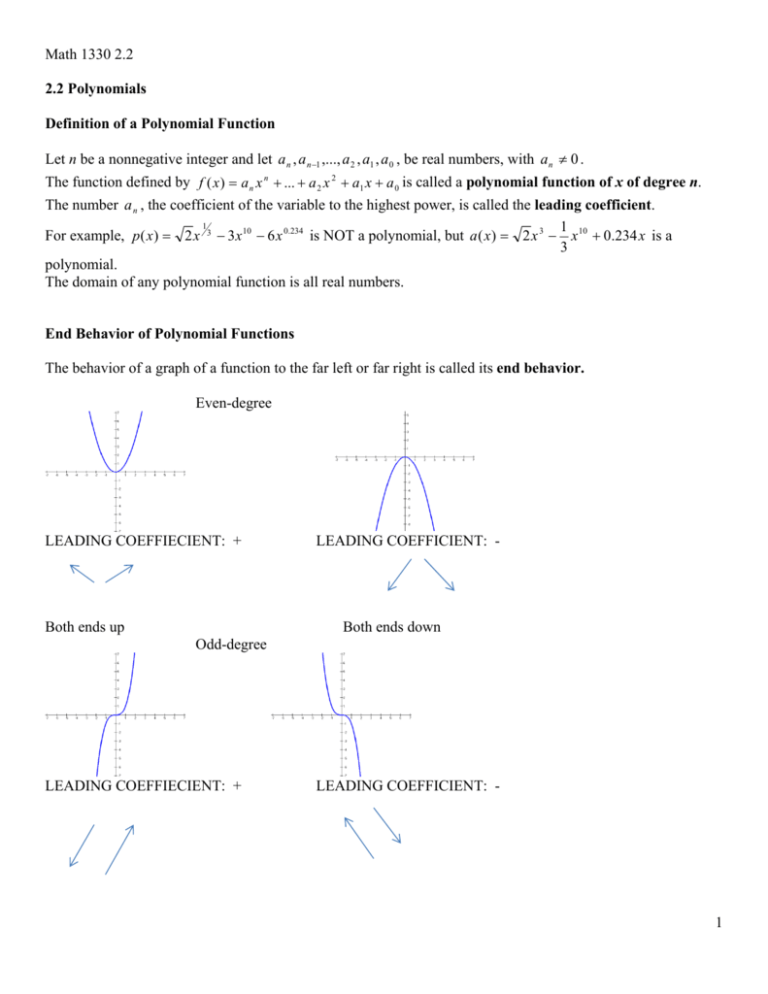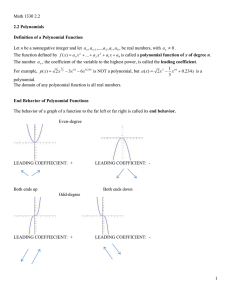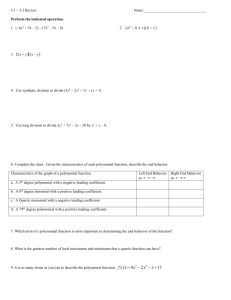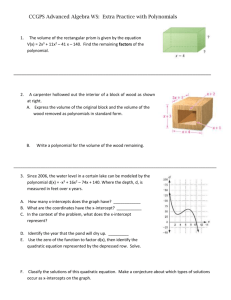Math 1330 2.2 1 2.2 Polynomials Definition of a Polynomial Function
advertisement

Math 1330 2.2 2.2 Polynomials Definition of a Polynomial Function Let n be a nonnegative integer and let a n , a n 1 ,..., a 2 , a1 , a 0 , be real numbers, with a n 0 . The function defined by f ( x ) a n x n ... a 2 x 2 a1 x a 0 is called a polynomial function of x of degree n. The number a n , the coefficient of the variable to the highest power, is called the leading coefficient. 1 1 For example, p ( x ) 2 x 3 3 x 10 6 x 0.234 is NOT a polynomial, but a ( x ) 2 x 3 x 10 0.234 x is a 3 polynomial. The domain of any polynomial function is all real numbers. End Behavior of Polynomial Functions The behavior of a graph of a function to the far left or far right is called its end behavior. Even-degree LEADING COEFFIECIENT: + Both ends up LEADING COEFFICIENT: - Both ends down Odd-degree LEADING COEFFIECIENT: + LEADING COEFFICIENT: - 1 Math 1330 2.2 Rising Left to right Fall in Left to right Power functions: A power function is a polynomial that takes the form f ( x) ax n , where n is a positive integer. Modifications of power functions can be graphed using transformations. Even-degree power functions: Odd-degree power functions: Note: Multiplying any function by a will multiply all the y-values by a. The general shape will stay the same. Here is an example of a polynomial function: Zeros of polynomials: If f is a polynomial and c is a real number for which f (c ) 0 , then c is called a zero of f, or a root of f. If c is a zero of f, then c is an x-intercept of the graph of f. ( x c ) is a factor of f. 2 Math 1330 2.2 So if we have a polynomial in factored form, we know all of its x-intercepts. every factor gives us an x-intercept. every x-intercept gives us a factor. Example 1: Consider the function: f ( x ) 2( x 3 )( x 4 )( 2 x ) Zeros (x-intercepts): y-intercept: leading term and degree: Steps to graphing other polynomials: (Note: this approach is completely different from the method in the textbook!) 1. Factor and find x-intercepts. 2. Mark x-intercepts on x-axis. 3. Determine the leading term. Degree: is it odd or even? Sign: is the coefficient positive or negative? 4. Determine the end behavior. What does it “look like”? Odd Degree Sign (+) Odd Degree Sign (-) Even Degree Sign (+) Even Degree Sign (-) 3 Math 1330 2.2 5. For each x-intercept, determine the behavior. Even multiplicity: touches x-axis, but doesn’t cross (looks like a parabola there). Odd multiplicity of 1: crosses the x-axis (looks like a line there). Odd multiplicity 3 : crosses the x-axis and looks like a cubic there. 6. Draw the graph, being careful to make a nice smooth curve with no sharp corners. Example 2: Find the x and y intercepts of the graph of the function. State the degree of the function. P( x) x 3 x 1x 2 . Then sketch the graph of the function, labeling all intercepts. Show the correct behavior at each x intercept and show the proper end behavior. 4 Math 1330 2.2 Example 3: Find the x and y intercepts of the graph of the function. State the degree of the function. 3 2 P ( x ) x 1 x 2 x 1 . Then sketch the graph of the function, labeling all intercepts. Show the correct behavior at each x intercept and show the proper end behavior. Example 4: Write the equation of the cubic polynomial P(x) that satisfies the following conditions: zeros at x 3, x 1, and x 4 and passes through the point (-3, 7). Example 5: Write the equation of the quartic function with y intercept 4 which is tangent to the x axis at the points (-1, 0) and (1, 0). 5 Math 1330 2.2 Example 6: Find the equation for the following graph. Example 7: Find the equation for the following graph. 6 Math 1330 2.2 Example 8: Find the equation for the following graph. Example 9: Graph the following function: 2 3 7






